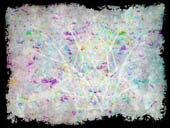
Purpose
To make swirling pattern on paper for unique designs, mimicking marble.
Additional information
Paper marbling is a process of transferring colors to paper or fabric by method of aqueous surface design, resulting in a pattern that is reminiscent of marble. This process can be traced as far back as the 10th century with the decorative paper called liu sha jian meaning “drifting-sand” or “flowing-sand notepaper". The paper was fashioned by dragging it through fermented flour paste, mixed with various colors. The result was a free and radical design unlike any other. Another type of ancient marbling involved paste from honey locust pods. This paste would be mixed with croton oil and thinned with water while ginger would be used to disperse colors. A hair brush would be whisked over the mixture and dandruff flakes added as part of the design. The finished art would resemble that of human figures and nature once they were transferred to a sheet of paper.
Sponsored Links
Required materials
- Different colored oil paints
- Mineral turpentine
- Teaspoon (for measuring)
- Several sheet of white or pale-colored paper
- Large shallow tray, at least as big as your paper
- Small plastic or glass containers for mixing your paint
- Newspaper
- Water
- Rubber gloves (for safety when handling turpentine)
- Several wooden sitr sticks (use spoons if you don't have stir sticks available)
Estimated Experiment Time
About 20 minutes for the procedure, up to an hour for the drying process.
Step-By-Step Procedure
- 1. Fill your tray about one-half way with water.
- 2. In your plastic/glass containers, mix a small amount of paint with some turpentine. Make sure to mix well with your stir sticks or spoon.
- 3. Use the teaspoon to careful pour a small amount of each mixed color from the containers onto the water in the tray. The color mixtures should float on top of the water.
- 4. Now, gently swirl the colors together with your teaspoon until they start to cover a larger area of the tray.
- 5. Gentry lie a sheet of paper on the surface of the water. Be careful not to capture any air bubbles.
- 6. Life the paper off and allow it to drain. Place the paper on top of a newspaper on a flat surface so it can dry.
- 7. Repeat steps 5 and 6 with other sheets of paper. With each pass the color will become more delicate. Soon you'll need to add more colors. Don't forget to swirl the colors as their added.
Note
Turpentine can be harmful. Always wear gloves when handling! If you don't have gloves available, always make sure to wash your hands with soap and water after handling the turpentine. Also be careful not to breathe in the chemical for a long period of time.
Observation
What kind of pattern did your paint make? Try mixing different color paints and adding them to the tray for some very unique and colorful results! You can even theme your marbling. For example, you can try using just reds and green during the holidays, or orange and brown during Thanksgiving. Be creative, try different things, and have fun!
Result
The oil paints mix with the mineral turpentine, which doesn't mix with water. Instead of mixing with the water it floats on top of it (similar to oil from an oil spill). As you swirl the paint gently, the colors make random patterns. You can transfer (or pick up) these patterns as you gently place your paper on the surface of the water and life it off.
All of your patterns on each sheet of paper will be different. You can use the sheets of paper as wrapping paper, wall art, or use them to make interesting and unique cards for family and friends.
Sponsored Links
Take a moment to visit our table of Periodic Elements page where you can get an in-depth view of all the elements,
complete with the industry first side-by-side element comparisons!